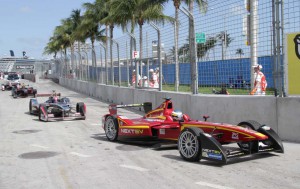Rain or shine, drivers will switch on their engines for the sixth round of the Formula E race series in Long Beach, California this weekend.
No matter what the weather, the 20 drivers in the battery-car racing program will ride the same set of rubber – in sharp contrast to the better-known Formula One series where teams can choose from an assortment of different tires customized for wet or dry pavement. In fact, the strict, green-minded rules of Formula E mean that drivers will likely be using some of the same tires that were on the car during the previous race in Miami.
That may pose some challenges for those drivers, considering Formula E cars will can launch from 0 to 60 in barely 2.8 seconds and reach speeds of nearly 150 mph. But it also could be good news for the average motorist, as the technology that makes it possible to handle such extremes on track should translate into better tires for the street, according to officials at Michelin, the official tire supplier for the Formula E series.
In a Formula One race, there will be as many as 100 tires per car, with each racer pitting and changing tires several times, notes Serge Grisin, head of the Formula E project for Michelin. In the battery-car series each car has just the four it rides on and a single spare, with no tire changes during the race, unless there’s an accident.
(Is th ePrix the future of racing? Click Here for more on Formula E.)
Meanwhile, says Grisin, Formula E tires have a number of other differences, who notes “These are very dedicated tires.” They blend the design of a racing slick with the grooved design of a rain tire, for one thing. And, at 18 inches, they’re about the same size as a tire you might find on a Corvette Z06, rather than the 13-inch tires – with massive sidewalls – used in the Formula One series.
“You lose a bit” because of the design, “but you gain a lot,” contends Pascal Couasnon, the overall head of motorsports for Michelin.
(Plans to develop a street version of exotic DeltaWing racer moving forward. Click Here for the latest.)
The unusual construction for a race tire reflects the unusual nature of Formula E. The series is intended to not only provide some good racing but to show the potential of alternative power. But teams also have to deal with the limits of today’s battery technology. Instead of pitting for fuel and fresh tires, for example, each driver switches cars halfway through a race.
And even getting that far required a lot of engineering. The Formula E cars feature some of the latest in aerodynamic design. Meanwhile, their tires are designed to minimize the amount energy normally lost by a tire simply as it rolls along the ground. So-called rolling resistance typically accounts for as much as a quarter of the energy a vehicle uses.
If anything, the Formula E series is actually a more valuable racing program for a company like Michelin, suggests Cuasnon, at least measured in terms of the potential transfer of technology.
“These are very close to a street tire,” he explains, “so what we learn can be transferred very, very quickly” from track to street. The French executive estimates some of the knowledge being generated by the Formula E series “will be used on the road within three years.”
Initially, the payoff will likely come with high-performance tires like the Pilot Super Sport rubber used on such vehicles as the Corvette Z06. But even more mundane street vehicles could eventually find themselves using tires that deliver both better grip and improved mileage thanks to the new battery-car race program.
(McLaren set to launch new Sport Series in NY with debut of 570S model. Click Here for more.)


This is precisely why manufacturers participate in motorsport – to develop technology that they can use for consumer products. Otherwise the cost is just too high for marketing purposes only.